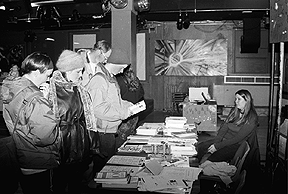








Junior Jason Haber never thought he'd find himself confined to a wheelchair. But there he was, forced to maneuver himself and his wheelchair around bulky furniture in a seemingly miniature room.
Minutes later, Haber stepped out of the chair to experience blindness for a few minutes. Wednesday's Disabilities Fair, sponsored by Students Overcoming Barriers in Education (SOBIE), offered Oberlin students the opportunity to better understand a range of disabilities through simulations.
"I think it's important for people to realize this is only an afternoon," said sophomore Jody Weinstein, co-chair of the event. "People who are disabled deal with this every day. We want to spread awareness through information, interaction and demonstrations."
Haber, having narrowly completed the wheelchair obstacle course, said, "It made me aware of how it would be to be disabled. I ran into a lot of things."
Junior Elana Gartner, co-chair of SOBIE, said, "I need to get better at my obstacle course."
The simulations were scattered among tables hosted by different support organizations for people with disabilities including the Counseling Center, Easter Seals and the National Federation of the Blind. Organizations distributed pamphlets detailing disabilities ranging from alcoholism to albinism to Attention Deficit Disorder.
According to Dean Kelly, coodinator of Oberlin Services for Students with Disabilities, 175 Oberlin students identify themselves as disabled.
"We're showing medical, physical, emotional and learning disabilities," said Weinstein.
Representatives of the Counseling Center hooked up willing participants to a biofeedback machine to measure stress levels. The Counseling Center handed out motivational buttons reading, "Creativity starts where relaxation starts," and "tools of relaxation" such as candy and condoms to students who weren't entirely stress-free.
Paul, a sophomore, staffed the emotional disabilities booth. "We're supposed to symbolize both emotional disabilities and how physical disabilities affect your emotional state," Paul said. "For some people the emotional baggage that comes from being disabled is worse than the disability itself."
The fair inspired a host of different reactions among visitors. "We've had everything from `I didn't know what this was' to `So that's what the posters are about'" Gartner said.
"Some people said `I thought you had to be in a wheelchair," Weinstein said.
At the learning disabilities booth, participants were asked to copy an entire page of text with their non-dominant hand to simulate dysgraphia, a writing disability. "They're surprised at how hard it is," said the student staffing the demonstration. "People get about three words done and they get frustrated."
Paul, who admitted his booth hadn't been very popular yet, said "I wouldn't blame anyone for coming to the fair just to hear Toshio and Bill."
Conservatory sophomores Toshio Mana and Bill Stevens are musicians with disabilities. Mana, who is hearing impaired, is a double-bass player. Stevens, who is blind, is a piano player. The duet provided the fair's musical accompaniment.
"They've been called disabilities," Weinstein said. "I understand why it's called a disability but I just call it different."
Checking out the awareness wares: Junior Ikenouye and Meredith Kreibel OC '96 go to the fair. Brochers detailed a variety of disabilites (photo by Christina Rudden)

Copyright © 1996, The Oberlin Review.
Volume 125, Number 9; November 15, 1996
Contact Review webmaster with suggestions or comments at ocreview@www.oberlin.edu.
Contact Review editorial staff at oreview@oberlin.edu.